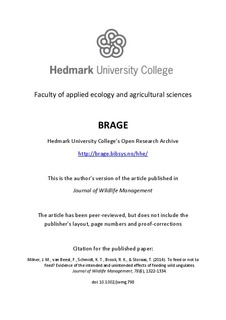| dc.contributor.author | Milner, Jos M. | |
| dc.contributor.author | van Beest, Floris M. | |
| dc.contributor.author | Schmidt, Karoline T. | |
| dc.contributor.author | Brook, Ryan K. | |
| dc.contributor.author | Storaas, Torstein | |
| dc.date.accessioned | 2015-02-23T13:41:12Z | |
| dc.date.available | 2015-02-23T13:41:12Z | |
| dc.date.issued | 2014 | |
| dc.identifier.citation | Milner, J. M., van Beest, F., Schmidt, K. T., Brook, R. K., & Storaas, T. (2014). To feed or not to feed? Evidence of the intended and unintended effects of feeding wild ungulates. Journal of Wildlife Management, 78(8), 1322-1334. doi: 10.1002/jwmg.798 | nb_NO |
| dc.identifier.uri | http://hdl.handle.net/11250/277202 | |
| dc.description.abstract | Ungulate populations are important natural resources, associated with both costs and benefits. Conflicts have arisen between stakeholders who benefit from high ungulate numbers and those faced with the costs. Supplementary or diversionary feeding may potentially mitigate conflicts while maintaining harvest yields but can have conservation implications. We quantified the empirical evidence for whether the intended effects, and hence management goals, of feeding are met. We also examined whether any potential unintended consequences of feeding occur and under what conditions. We found clear evidence that supplementary feeding enhanced reproduction and population growth under certain conditions. By contrast, we found limited evidence of the effectiveness of diversionary feeding to protect crops, forestry, and natural habitats, with positive effects often undermined by increases in ungulate density. However, the use of diversionary feeding to reduce traffic collisions seems promising but requires further investigation. The unintended effects of feeding are typically complex, involving changes to demography, behavior, and vegetation with consequent cascading effects on other trophic levels, as well as exacerbated risks of disease transmission. Increased ungulate density is the primary driver behind these unintended effects, the consequences of which tend to increase with longevity of feeding and affect a range of stakeholders. We urge managers to take seriously the risks as well as the economic and ethical issues before deciding to feed ungulates | nb_NO |
| dc.language.iso | eng | nb_NO |
| dc.publisher | Journal of Wildlife Management | nb_NO |
| dc.subject | artificial feeding | nb_NO |
| dc.subject | deer | nb_NO |
| dc.subject | forest damage | nb_NO |
| dc.subject | habitat impact | nb_NO |
| dc.subject | herbivore | nb_NO |
| dc.subject | hunting | nb_NO |
| dc.subject | supplemental feed | nb_NO |
| dc.subject | sustainable management | nb_NO |
| dc.subject | vehicle collision | nb_NO |
| dc.subject | wildlife disease | nb_NO |
| dc.title | To feed or not to feed? Evidence of the intended and unintended effects of feeding wild ungulates | nb_NO |
| dc.type | Journal article | nb_NO |
| dc.type | Peer reviewed | nb_NO |
| dc.source.pagenumber | 1322-1334 | nb_NO |
| dc.source.volume | 78 | nb_NO |
| dc.source.journal | Journal of Wildlife Management | nb_NO |
| dc.source.issue | 8 | nb_NO |
| dc.identifier.doi | 10.1002/jwmg.798 | |
